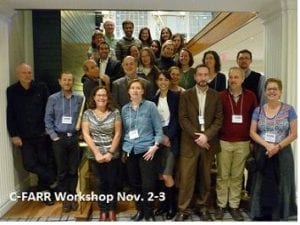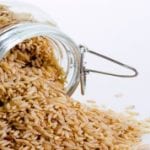Latest C-FARR Paper Published on Rice Intake
The paper, Rice Intake and Emerging Concerns on Arsenic in Rice: a Review of the Human Evidence and Methodologic Challenges, which was published in the journal Current Environmental Health Reports, summarizes “…the state of the epidemiologic evidence on whether rice consumption relates to health outcomes associated with arsenic exposure.” The article recommends that “further studies are needed to understand the health impacts of arsenic exposure from rice consumption taking into account all sources of rice intake and potential confounding by other dietary constituents or contaminants and arsenic exposure from sources such as water.” Dartmouth Superfund Research Program (SRP) researchers Margaret Karagas (lead author) and Tracy Punshon are co-authors.
Brief Published in EHP Moves C-FARR Work Forward
The Brief Communication paper, Opportunities and Challenges for Dietary Arsenic Intervention, discusses a framework for short-term interventions for reducing dietary arsenic exposure and is a product of C-FARR which brought arsenic and food scientists together with policy stakeholders for a workshop focusing on knowledge gaps and policy questions in 2015 and resulted in the five papers listed below.
C-FARR Papers Published in Science of the Total Environment
The five C-FARR synthesis papers are published in an online Virtual Special Section and listed below.
- Punshon, T., et al., Understanding arsenic dynamics in agronomic systems to predict and prevent uptake by crop plants, Sci Total Environ (2016).
- Cubadda, F., et al., Human exposure to dietary inorganic arsenic and other arsenic species: State of knowledge, gaps and uncertainties, Sci Total Environ (2016).
- Taylor, V., et al., Human exposure to organic arsenic species from seafood, Sci Total Environ (2016).
- Davis, M., et al., Assessment of Human Dietary Exposure to Arsenic through Rice, Sci Total Environ (2017).
- Nachman, K.E., et al., Mitigating dietary arsenic exposure: Current status in the United States and recommendations for an improved path forward, Sci Total Environ (2016).
Special Session: 
From Soil to Plate to Policy

The AAAS Session, Arsenic in Food: From Soil to Plate to Policy, based on our C-FARR work, was attended by 60 people including the press. The news briefing that followed was well attended and generated articles in Science and Science News.
C-FARR Workshop
 Over 35 researchers, policy stakeholders and program leaders attended a two-day workshop in Hanover, NH, in November 2015, for the Collaborative on Food with Arsenic and associated Risk and Regulation (C-FARR). The group discussed the issue of arsenic in food and the ways in which the science can better inform policy to protect public health. The resulting five papers have been published in a special section of the journal, Science of the Total Environment (STOTEN) and translation products include the website Arsenic and You.
Over 35 researchers, policy stakeholders and program leaders attended a two-day workshop in Hanover, NH, in November 2015, for the Collaborative on Food with Arsenic and associated Risk and Regulation (C-FARR). The group discussed the issue of arsenic in food and the ways in which the science can better inform policy to protect public health. The resulting five papers have been published in a special section of the journal, Science of the Total Environment (STOTEN) and translation products include the website Arsenic and You.
Background
Recent research has revealed that arsenic is taken up in food crops and has resulted in significant exposure to humans through the consumption of rice, apple juice, and other foods and beverages. To date, arsenic policy and regulation has focused on exposure through drinking water due to the high levels of arsenic in groundwater in certain regions of the world. However, recent studies have shown that food is a larger source of arsenic exposure for populations whose drinking water does not exceed the World Health Organization recommended standard for arsenic. 
 Arsenic exposure through food is therefore far more widespread, and may pose greater risk to different sensitive populations, particularly children, pregnant women and those with specific diets, than arsenic in drinking water. In April 2014, the WHO/FAO Codex Alimentarius Commission released its recommendation for maximum levels of inorganic arsenic in polished rice, but much remains to be done to address these complex issues.
Arsenic exposure through food is therefore far more widespread, and may pose greater risk to different sensitive populations, particularly children, pregnant women and those with specific diets, than arsenic in drinking water. In April 2014, the WHO/FAO Codex Alimentarius Commission released its recommendation for maximum levels of inorganic arsenic in polished rice, but much remains to be done to address these complex issues.
The Collaborative on Food with Arsenic and associated Risk and Regulation (C-FARR), sponsored by the Dartmouth College Toxic Metals Superfund Research Program and the Children’s Environmental Health and Disease Prevention Research Center at Dartmouth, has addressed important issues surrounding arsenic in food. Guided by a steering committee and support staff, C-FARR convened a team of scientists and stakeholders to work together over a two-year period to gather and analyze data and publish a series of papers related to sources of arsenic and human exposure via food consumption. The salient findings from this initiative are being translated and distributed to public health and policy stakeholders.
C-FARR was based on the model of two workshops hosted in 2006 and 2010 by Dartmouth’s Toxic Metals Superfund Research Program, which focused on identifying research and monitoring needs for mercury in marine ecosystems and resulted in a meeting report in Environmental Health Perspectives and several special issues devoted to methylmercury in the journals Ecohealth, Environmental Health Perspectives and Environmental Research.
C-FARR Objectives
- To develop a network of scientists who study the fate of arsenic in food and the resulting exposure to humans;
- To facilitate communication between stakeholders and scientists about the important questions relevant to public health policy and regulation of arsenic in food in the U.S. and globally;
- To provide a forum for arsenic scientists including biologists, environmental chemists, agricultural and health scientists, epidemiologists, nutritionists and pediatricians to communicate their results to other investigators and facilitate the exchange of information;
- To identify key questions and knowledge gaps about arsenic in food and exposure to humans via consumption of rice and other foods containing arsenic, and to facilitate the analysis of existing data to address those questions;
- To identify a series of proposed manuscripts and applicable data sets addressing key questions and knowledge gaps, which will provide the foundation for publication of a special issue of a peer-reviewed journal.
C-FARR Steering Committee
The direction and organization of C-FARR was guided by a Steering Committee with representation from a range of arsenic research disciplines.
- Mary Lou Guerinot, Ph.D., Associate Director, Dartmouth Toxic Metals Superfund Research Program, Dartmouth College
- Brian Jackson, Ph.D., Leader, Trace Elements Core, Dartmouth Toxic Metals Superfund Research Program, Dartmouth College
- Margaret Karagas, Ph.D., Director, Children’s Environmental Health and Disease Prevention Research Center at Dartmouth and Research Project Leader, Dartmouth Toxic Metals Superfund Research Program, Dartmouth College
- Keeve Nachman, Ph.D., Director, Food Production & Public Health Program, Center for a Livable Future, Johns Hopkins University Bloomberg School of Public Health
- Tracy Punshon, Ph.D., Research Assistant Professor and Co-Leader, Trace Element Analysis Core, Dartmouth Toxic Metals Superfund Research Program, Dartmouth College
In addition, the C-FARR Steering Committee included Research Scientist and former Post-doctoral Trainee, Britton Goodale.
